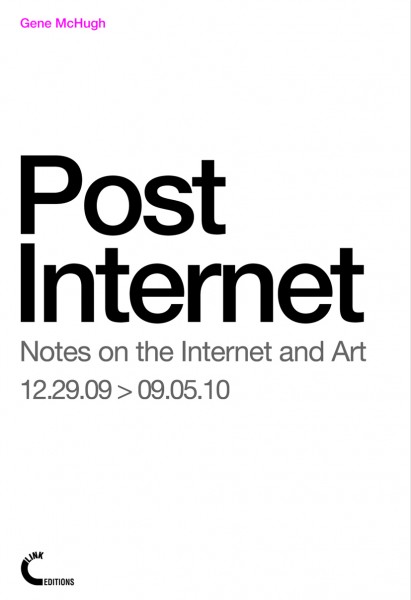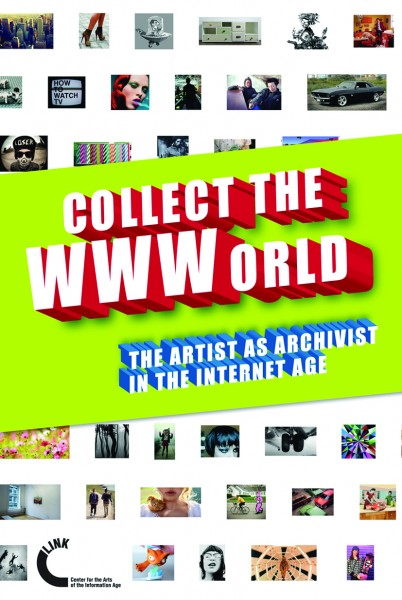Gene McHugh: Post Internet: Notes on the Internet and Art (2011)
Filed under book | Tags: · art, art criticism, contemporary art, internet, internet art, net art, post internet, surf club

“Post Internet is a blog developed between December 2009 and September 2010 by the New York based art critic Gene McHugh, thanks to a grant of the Creative Capital | Andy Warhol Foundation Arts Writers Grant Program.
For almost a year, McHugh kept filling this folder with his personal notes on contemporary art. Writing and posting became a daily, regular activity, that sometimes produced many posts a day, sometimes long (or very long) texts posted at a slower pace.
However, Post Internet is not just a piece of beautiful criticism, as reading this book proves. It’s also, in itself, a performance, and a piece of Post Internet art in the shape of an art criticism blog.”
Publisher LINK Editions, Brescia, September 2011
Creative Commons Attribution-NonCommercial-ShareAlike 3.0 Unported License
ISBN 9781447803898
274 pages
PDF (updated on 2022-7-3)
Comment (0)Domenico Quaranta (ed.): Collect the WWWorld: The Artist as Archivist in the Internet Age, catalogue (2011) [English/Italian]
Filed under catalogue | Tags: · archive, art, internet art, net art, surf club, tumblr, web

“The last decade has seen an incredible growth in the production and distribution of images and other cultural artefacts. The internet is the place where all these cultural products are stored, classified, voted, collected and trashed. What is the impact of this process on art making and on the artist? Which kind of dialogue is going on between amateur practices and codified languages? How does art respond to the society of information? This is a book about endless archives, image collections, bees plundering from flower to flower and hunters crawling through the online wilderness.”
With works by Alterazioni Video, Kari Altmann, Cory Arcangel, Gazira Babeli, Kevin Bewersdorf, Luca Bolognesi, Natalie Bookchin, Petra Cortright, Aleksandra Domanovic, Harm van den Dorpel, Constant Dullaart, Hans-Peter Feldmann, Elisa Giardina Papa, Travis Hallenbeck, Jodi, Oliver Laric, Olia Lialina & Dragan Espenschied, Guthrie Lonergan, Eva and Franco Mattes, Seth Price, Jon Rafman, Claudia Rossini, Evan Roth, Travess Smalley, Ryan Trecartin.
Includes texts by Josephine Bosma, Gene McHugh, Joanne McNeil, Domenico Quaranta.
Publisher LINK Editions, Brescia, September 2011
Creative Commons Attribution-NonCommercial-ShareAlike 3.0 Unported License
ISBN 9781447839491
160 pages
PDF, PDF (15 MB, updated on 2016-8-19)
Comment (1)Joasia Krysa (ed.): Curating Immateriality: The Work of the Curator in the Age of Network Systems (2006)
Filed under book | Tags: · aesthetics, art, collaboration, curating, database, exhibition, internet, internet art, labour, media art, museum, net art, open source, relational aesthetics, software art, technology

“The site of curatorial production has been expanded to include the space of the Internet and the focus of curatorial attention has been extended from the object to processes to dynamic network systems. As a result, curatorial work has become more widely distributed between multiple agents, including technological networks and software. This upgraded ‘operating system’ of art presents new possibilities of online curating that is collective and distributed — even to the extreme of a self-organising system that curates itself. The curator is part of this entire system but not central to it.
The subtitle of the book makes reference to the essay ‘The Work of Culture in the Age of Cybernetic Systems’ (1988), in which Bill Nichols considered how cybernetics transformed cultural production. He emphasised the shift from mechanical reproduction (symbolised by the camera) to that of cybernetic systems (symbolised by the computer) in relation to the political economy, and pointed to contradictory tendencies inherent in these systems: ‘the negative, currently dominant, tendency toward control, and the positive, more latent potential toward collectivity’. The book continues this general line of inquiry in relation to curating, and extends it by considering how power relations and control are expressed in the context of network systems and immateriality.
In relation to network systems, the emphasis remains on the democratic potential of technological change but also the emergence of what appears as more intensive forms of control. Can the same be said of curating in the context of distributed forms? If so, what does this imply for software curating beyond the rhetoric of free software and open systems?”
Contributors: 0100101110101101.ORG & [epidemiC] | Josephine Berry Slater | Geoff Cox | Alexander R. Galloway & Eugene Thacker | Olga Goriunova & Alexei Shulgin | Beryl Graham | Eva Grubinger | Piotr Krajewski | Jacob Lillemose | low-fi | Franziska Nori | Matteo Pasquinelli | Christiane Paul | Trebor Scholz | Grzesiek Sedek | Tiziana Terranova | Marina Vishmidt
Publisher Autonomedia/I-DAT, 2006
Creative Commons License
DATA browser series, 3
ISBN 1570271739
288 pages
PDF (14 MB, added on 2018-3-29)
PDFs (updated on 2016-12-12)

